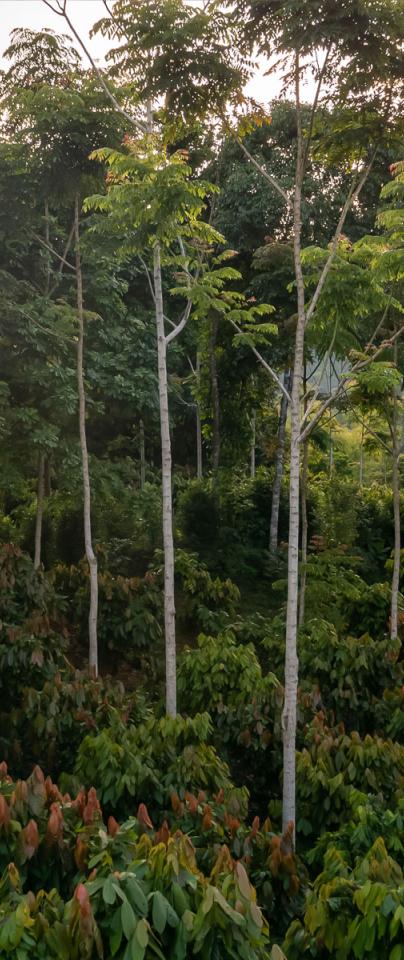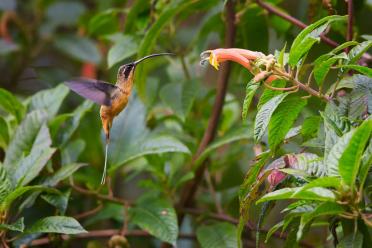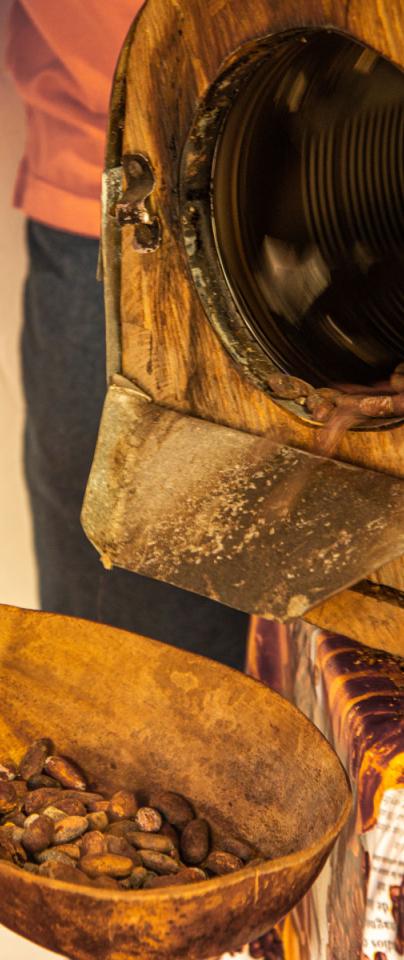The science putting sustainable chocolate on the shelves
Addictive, healthy, and we’re demanding more than ever: how are scientists in Colombia and the UK working to ensure a sustainable supply of chocolate?
Chocolate is big business, with an ever-increasing global demand. While it looks to be a sweet deal for big brands, it can still be an unsavoury prospect for the cacao farmers. Already cash-strapped and vulnerable to climate change, soil degradation and pests pose a significant barrier to the marketability and profitability of cacao. Researchers working on the GROW Colombia project are tackling all of this - combining bioscience with socioeconomics to ensure chocolate is plentiful for the consumer, environmentally sustainable in the long term, and profitable for those who produce it.
The global demand for chocolate continues to increase year on year, with forecasts predicting annual growth of 4.5% up to 2024. This would push the global chocolate market to a value of $140billion. The UK follows only Germany in the amount of chocolate sold, sharing a large chunk of Europe’s $44 billion market in 2017. The Swiss consume a whopping 10.5 kilograms of chocolate per person per year.
It’s hardly surprising, considering the mildly addictive and stimulating effects of chocolate - packed as it is with psychoactive components such as theobromine and caffeine; dark chocolate can contain up to 300mg and 35mg of these per 40g, respectively. Theobromine has also been linked with a number of positive health benefits relating to cardiovascular health, respiratory health, reducing inflammation and even anti-cancer effects.
All well and good, you might think. Bring me more!
However, the global cacao production system is faced with several threats to its long-term sustainability and productivity. Among them are drought, soil degradation, pests and disease. Less obvious, perhaps, is that cadmium-rich soils can lead to an accumulation of this toxic heavy metal in cacao beans. Another concern is an ageing population of smallholder farmers producing the essential ingredient of chocolate - cacao - who get a raw deal in comparison to the big companies making all of the profits.
That’s why scientists on the international GROW Colombia project, led by Professor Federica Di Palma and Professor in Schools of Biology and Medicine, UEA, are working to tackle the issues around chocolate production on several fronts. A diverse range of research projects are exploring how to improve the sustainability and marketability of Colombian cacao while improving the socioeconomic fortunes of smallholder farmers, making sustainable cacao production a more enticing prospect.
The GROW Colombia project draws on multidisciplinary expertise from around the world, including a team of dedicated socioeconomics experts led by Professor Kerry Turner at the University of East Anglia (UEA).
In a recent report, the UEA team details how cacao production can not only be made more sustainable, but also points to evidence that more sustainable farm management practices can result in better yields and greater profitability for smallholder farmers, who account for 90% of all cacao production worldwide.
Currently, most of the cacao grown around the world is done so in monoculture - heavily reliant on agrochemicals and intensive farming methods to sustain the high yields the world has increasingly demanded. However, this intensification of primary production of cacao comes with a number of environmental costs, including soil degradation and contamination with pollutants. Another is an alarming decline in biodiversity.
At the same time, as we are witnessing worldwide, monoculture agricultural systems are prone to changing environmental conditions, such as drought. They are also vulnerable to emerging pests and diseases, which can spread rapidly through crops if not kept in check with pesticides that can themselves go on to inflict yet more environmental damage.

Cacao agroforestry systems promote jointly biodiversity, ecosystem services conservation and significant livelihood gains to smallholder farmers.

One solution is agroforestry, a system by which farmers can grow cacao in a biodiverse community - shaded by native trees - which allows wildlife to thrive alongside crop production. The recent UEA report suggests that, not only is agroforestry a suitable substitute for conventional cacao farming, “cacao AFs promote jointly biodiversity, ecosystem services conservation and significant livelihood gains to smallholder farmers.”
In fact, the report notes that the shade provided by trees promotes pollination by cacao midges while also reducing the numbers of pest insect species, which are further reduced by the diverse communities of arthropods in agroforestry systems. Furthermore, in the context of Colombian agroforestry in particular, it has been shown that while cacao production specifically was no different compared to conventional monoculture - the yield of all products combined from agroforestry was 161% higher.


The shade provided by trees promotes pollination by cacao midges while also reducing the numbers of pest insect species, which are further reduced by the diverse communities of arthropods in agroforestry systems.

Another pertinent benefit to agroforestry in the Colombian context is that leaf cadmium content has been shown to be reduced in such systems. This is important because, although Colombia is naturally graced with conditions that are ideal for growing cacao, soils can be rich in cadmium. This problem affects crops worldwide, as cadmium can build up for a number of reasons, often after repeated use of phosphate-based fertilisers.
Unfortunately, this means that cacao can often have a high cadmium content. This poses a hindrance to the marketability of chocolate products - especially as the EU recently implemented a maximum cadmium content of 0.8mg/kg in dark chocolate containing 50% or more cacao.
That’s where the bioscience component of the GROW Colombia project comes in.
Researchers at Universidad de los Andes and Universidad del Rosario are looking at another aspect of biodiversity to aid Colombia’s chocolate producers; identifying genes in the wild relatives of cacao that will help us to better understand how different plants accumulate and transport cadmium. This project is aligned with the Cacao Bio expedition from MinCiencias in collaboration with AGROSAVIA.
According to Dr Ana Bossa-Castro, a postdoctoral researcher on the project, “only a small proportion of the genetic diversity of cacao and related species is used in the global production of this crop, which is why we’re studying cacao’s wild relatives. The knowledge we will glean will help us to develop low cadmium-accumulating varieties, which will increase the marketability of cacao and make it a more profitable alternative for Colombian farmers.”

The cacao plant is just one member of a larger tribe of plants known as the Theobromeae - the name being derived from the latin name of cacao itself (Theobroma cacao). The GROW research team have selected eight collections worldwide and collected 280 samples from all 45 species of the Theobromeae from 22 countries. Colombia itself is a hotspot of cacao diversity - home to almost 50% of the species in this group.
Dr James Edward Richardson of the Universidad del Rosario explains: “Theobroma cacao is a species of great antiquity, thought to be approximately ten million years old. Given the age of the species, it should be no surprise that wild populations are highly diverse genetically with variants that could have important features useful to the industry.
“Colombia has representatives of all of the major genetic variants of cacao identified thus far and arguably could also be considered the centre of genetic diversity for the species .”
By analysing the DNA sequences of these plants the team will be able to understand how each plant species is related to another, and also to identify genes that are associated with cadmium. Other important indicators are also being investigated, including genes that might confer resistance to pathogens causing blight, witches’ broom disease, or pod rot disease, all of which pose a significant threat to cacao production in Colombia.

Are people willing... to pay for the social and the environmental benefits derived from growing sustainable cacao beans in rural Colombia?

The dual approach of agroforestry with crop breeding programmes, selecting for greater disease resistance and reduced cadmium uptake, offers a potential step forward. However, the interests of smallholder farmers must also be taken into account if that potential is to be realised, especially if we are to make cacao farming a more attractive prospect than, say, illicit medicinals, or unsustainable cacao production.
The UEA socioeconomics team reports that “farmers are currently receiving an insufficient price increase for the added labour associated with appropriate post-harvest practices” relevant to agroforestry systems. So, despite there being an increasing demand for sustainable chocolate from consumers, farmers are currently not receiving nearly enough incentive to switch to this system.
There is, therefore, “scope for implementing additional financial incentives, such as payments for ecosystem services or certification schemes which incentivise smallholder farmers to switch from their current management practices.”
For this to happen, it’s likely that customers will have to pay a premium, which is an area the UEA team is investigating as part of the GROW Colombia project. What are consumers willing to pay for a certain type of product? Are people willing to put their hands a little deeper into their pockets for products with greater flavour, “but also to pay for the social and the environmental benefits derived from growing sustainable cacao beans in rural Colombia”?


The success of Colombia’s cacao-farming future hinges on a combinatorial approach.

The success of Colombia’s cacao-farming future hinges on a combinatorial approach. Sustainability and economics are absolutely intertwined, and we can’t possibly hope to find solutions to our problems if we don’t take into account the wider context. Amongst all of this, another aim of the GROW Colombia project is to help support a sustainable peace process.
It’s all well and good having a potential solution to increasing the sustainability of cacao but, if this is not profitable for the farmer, we will never be able to fully implement it. It’s all well and good to produce more cacao but, if it cannot be sold due to its high cadmium content, then that extra production is futile.
The GROW Colombia project is tying all of these different strings together to make a more robust safety net for the future of cacao, biodiversity, and the livelihoods of smallholder farmers in Colombia.